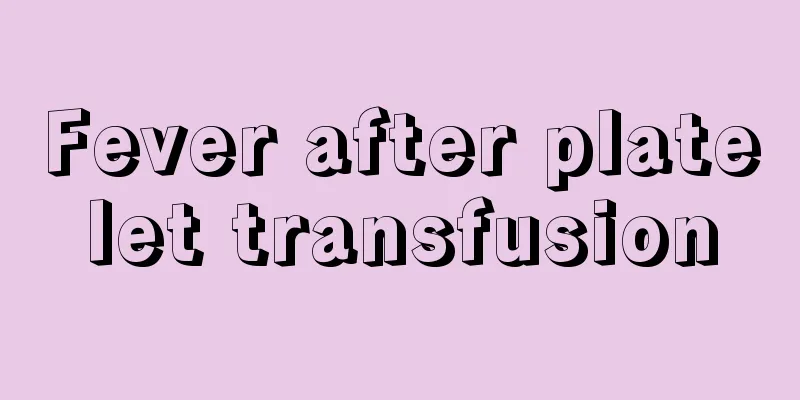Fever after platelet transfusion

|
Platelets are an important component of blood and are a substance that many patients need to transfuse during the treatment process. Of course, platelet transfusion can greatly improve the patient's condition, but after platelet transfusion, the patient will also experience many adverse symptoms, such as fever. Next, I will introduce to you the dosage, method and precautions of platelet transfusion! 1. Platelet transfusion dose The platelet transfusion dose depends on the patient's pretransfusion platelet count and the desired platelet count to be achieved. my country stipulates that each bag of single-donor platelets (1 therapeutic dose) should contain ≥ 2.5×1011 platelets. Adults receive 1 therapeutic dose (1 bag) each time, while larger patients may need an appropriate increase in the dose. The platelet transfusion dose for children is determined based on their weight or body surface area. After transfusion, the subsequent transfusion plan is formulated based on the increase in platelet count and clinical conditions. 2. Platelet transfusion method To prevent fibrin clots from being transfused into the patient, a standard transfusion set with a pore size of 170 u should be used when transfusing platelets. The platelets should be used immediately and transfused rapidly at a rate that the patient can tolerate. During the infusion, especially within 15 minutes after the start of the infusion, the patient should be closely observed for signs of bacterial contamination, fever, and allergic reaction. In case of mild allergic adverse reactions, the infusion should be slowed down or stopped, and antihistamines should be given; in case of severe reactions, the infusion should be stopped and supportive treatment should be given, and the remaining blood should be sent to the transfusion department for further analysis. When the platelets are almost completely transfused, the blood bag is rinsed with 0.9% sodium chloride solution so that the platelets adhering to the inner wall of the blood bag can also be transfused into the patient. 3. Precautions for platelet transfusion 1. Platelet transfusion should be considered comprehensively based on the patient's condition, platelet count and function, bleeding conditions, and the cause of thrombocytopenia. 2. Generally speaking, routine blood matching is not required before platelet transfusion. Cross-matching test is only required when the red blood cell content in the platelet product is greater than 5ml. Because there are ABO antigens on the platelet membrane, platelet transfusion requires transfusion of the same ABO blood type. In emergency situations, single-donor platelets of different but compatible ABO types can be transfused. 3. Prophylactic platelet transfusion requires observation of whether the platelet count increases after transfusion, while therapeutic platelet transfusion requires observation of whether bleeding is alleviated or stopped after transfusion. Whether the platelet count increases or not is not the only indicator for evaluating efficacy. |
<<: Basic principles of blood transfusion
>>: How to treat frontal sinusitis
Recommend
What are the disadvantages of aspherical lenses?
Nowadays, there are more and more people who are ...
Chinese medicine for treating sore throat
Traditional Chinese medicine is a kind of medicin...
What are the symptoms of renal hamartoma
The incidence of renal hamartoma is increasing. A...
Difference between sarcoma and osteosarcoma
The main difference between sarcoma and osteosarc...
What are the symptoms of mid- to late-stage liver cancer? What are the treatments for mid- to late-stage liver cancer?
As the disease progresses, the clinical symptoms ...
What is the weaning massage technique?
If a postpartum woman wants to wean, she must not...
How to prevent and treat burn sepsis, comprehensive measures are the key
Burns are very common in our daily lives. Burns m...
Using mosquito coils to repel mosquitoes in summer is very harmful! Light this thing and the mosquitoes will disappear without a trace
With the arrival of summer, there are more mosqui...
TCM Syndrome Differentiation and Classification of Advanced Esophageal Cancer
A 76-year-old male patient was diagnosed with adv...
What are the precautions for wearing dentures
Dental problems are a common phenomenon in our li...
Patients with breast cancer may generally experience local bulges in the breast
Breast cancer patients may experience local swell...
What are the side effects of bone grinding surgery
In order to make their face look more delicate an...
There is salt on the sweaty clothes
Many people sweat in life, which is actually the ...
Method of preauricular fistula resection
I believe everyone knows about the disease called...
How to deal with a pregnant woman filing for divorce
Family disputes have always been a very troubleso...









